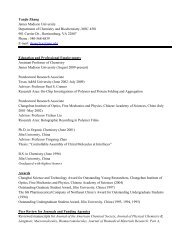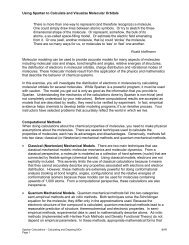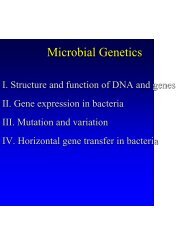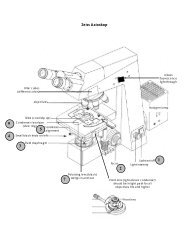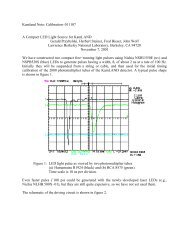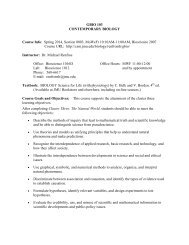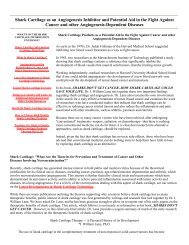A History of Genetics and Genomics - College of Science and ...
A History of Genetics and Genomics - College of Science and ...
A History of Genetics and Genomics - College of Science and ...
Create successful ePaper yourself
Turn your PDF publications into a flip-book with our unique Google optimized e-Paper software.
A <strong>History</strong> <strong>of</strong> <strong>Genetics</strong> <strong>and</strong> <strong>Genomics</strong>Phil McCleanSeptember 2003<strong>Genomics</strong> is a recent convergence <strong>of</strong> many sciences including genetics, molecularbiology, biochemistry, statistics <strong>and</strong> computer sciences. Before scientists even uttered the wordgenomics, these other fields were richly developed. Of these fields, the history <strong>of</strong> genetics <strong>and</strong>molecular biology are particularly relevant to the techniques, experimental designs, <strong>and</strong>intellectual approaches used in genomics. The development <strong>of</strong> computers <strong>and</strong> the internet hasprovided researchers ready access to the large body <strong>of</strong> information generated throughout theworld. Table 1 is an extensive history <strong>of</strong> the major developments in these fields. The narrativewill try to unify some <strong>of</strong> these discoveries into major findings.Mid to Late 19 th Century: Evolution, Natural Selection, Particulate Inheritance <strong>and</strong> NucleinUnderst<strong>and</strong>ing origins is a constant pursuit <strong>of</strong> man. In the 1858, our underst<strong>and</strong>ing <strong>of</strong> theorigin <strong>of</strong> species <strong>and</strong> how species variability arose was revolutionized by the research <strong>of</strong> Darwin<strong>and</strong> Wallace. They described how new species arose via evolution <strong>and</strong> how natural selectionuses natural variation to evolve new forms. The importance <strong>of</strong> this discovery was reflected inthe now famous quote <strong>of</strong> Dobzhansky:“Nothing in biology makes sense except in the light <strong>of</strong> evolution.”- Theodore Dobzhansky, The American Biology Teacher, March 1973A few years later, Gregor Mendel, an Austrian monk, summarized his years <strong>of</strong> researchon peas in his famous publication. In that paper, he described the unit <strong>of</strong> heredity as a particlethat does not change. This was in contrast to the prevailing “blending theory <strong>of</strong> inheritance.”Equally important, Mendel formalized the importance <strong>of</strong> developing pure (genotypicallyhomozygous) lines, keeping careful notes, <strong>and</strong> statistically analyzing the data. His approach <strong>of</strong>crossing individuals with variable phenotypes <strong>and</strong> following them in successive generations isstill the only approach utilized to underst<strong>and</strong> the genetic inheritance <strong>of</strong> a trait. Others in thiscentury were concluding that statistical approaches to biology would help solve problems inbiology <strong>and</strong> inheritance.Research in the 19 th century was <strong>of</strong>ten performed in isolation. While Mendel wasconcluding that inheritance was particulate in nature, others were trying to figure out the physicalnature <strong>of</strong> the particle. Haeckel correctly predicted that the heredity material was located in thenucleus. Miescher showed the material in the nucleus was a nucleic acid. Others observed thebehavior <strong>of</strong> chromosomes <strong>and</strong> suggested they had a role in heredity. One wonders how conceptsmight have evolved if information was mobile at that time as it is today.
Early 20 th Century: Mendelian Principles are extended <strong>and</strong> the Chromosomal Theory <strong>of</strong>Inheritance solidifiesExcept for his early adult years, Mendel did not have an active research program.Therefore, his groundbreaking research went largely unnoticed. It was not until 1900 that others,who had performed similar experiments to his, arrived at the same conclusions. Theirpublications cited his work, leading to a rediscovery <strong>of</strong> the Mendelian principles. Quicklyfollowing the rediscovery, other genetic principles such as linkage, lethal genes, <strong>and</strong> a bit later,maternal inheritance were described. In each case, the principles provided to be simpleextensions <strong>of</strong> the Mendelian laws, providing further evidence <strong>of</strong> their importance.At the beginning <strong>of</strong> the century, the work on chromosomes coalesced into thechromosomal theory <strong>of</strong> inheritance. This theory focused research on the chromosome as thelocation <strong>of</strong> genes. The field <strong>of</strong> cytogenetics was based on this discovery. The first observations<strong>of</strong> chromosomal abnormalities (duplications, deletions, translocations, inversions) are reported.Observations such as position effect demonstrate that there is a direct link between chromosomestructure <strong>and</strong> phenotype. All <strong>of</strong> these discoveries justified research to discover the physical basis<strong>of</strong> heredity.Mid 20 th Century: DNA is the stuff <strong>of</strong> life; the preeminence <strong>of</strong> the Darwinian theory <strong>of</strong>evolution via natural selection is confirmedAs early as the 1870s, the material in the nucleus was determined to be a nucleic acid.From the 1920s through the mid-1950s, a series <strong>of</strong> experiments demonstrated that DNA wasindeed the genetic material. The transformation experiments <strong>of</strong> Griffith demonstrated that afactor found in a lethal strain <strong>of</strong> bacteria could convert a non-lethal strain <strong>of</strong> the bacteria into alethal strain. It was the careful experiments <strong>of</strong> Avery, MacLeod <strong>and</strong> McCarty that determinedDNA, not protein or RNA was the factor responsible for the conversion. This was furtherconfirmed by Hershey <strong>and</strong> Chase, although their experiments had flaws which prevented themfrom being definitive. Watson <strong>and</strong> Crick determined the structure <strong>of</strong> DNA, <strong>and</strong> others suggestedthat DNA contained a genetic code. By the mid 1960s that code was deciphered. Experimentsinvolving the process <strong>of</strong> transcription <strong>and</strong> translation led to the development <strong>of</strong> the “centraldogma <strong>of</strong> molecular biology” concept by Crick.The experiments <strong>of</strong> the early 19 th century that confirmed that Mendelian principles couldbe extended to many gene systems became a major component <strong>of</strong> what was to be called theModern synthesis (on neo-Darwinism). The experimental demonstration that mutations could beinduced was also an important component <strong>of</strong> the solidification <strong>of</strong> the concept that naturalselection was a major factor in evolution. Finally, the theories embodied in population geneticswere also critical. The synthesis states that mutations create variation; recombination developsnew forms, the variation extends through the population, <strong>and</strong> based on environmental constraintsthe variation is finally acted upon by the forces <strong>of</strong> natural selection to produce more fitindividuals.2
Mid-late 20 th Century <strong>and</strong> the Early Days <strong>of</strong> the 21 st Century: The Age <strong>of</strong> Molecular <strong>Genetics</strong>;Phylogenetics Studies Intensive; The Information Age; The Emergence <strong>of</strong> <strong>Genomics</strong> <strong>Science</strong>The discoveries <strong>of</strong> the mid to late 20 th century defined processes that would provide thetools for molecular biology, recombinant DNA technology, <strong>and</strong> finally the biotechnologyindustry. The elucidation <strong>of</strong> the process <strong>of</strong> DNA replication described the necessary componentsneeded for the widely-used chain termination DNA sequencing procedure. Underst<strong>and</strong>ingreplication helped determine those tools necessary for the radiolabelling <strong>of</strong> DNA. Thedevelopment was necessary to support Southern hybridizations <strong>and</strong> the early molecular mappingexperiments. Underst<strong>and</strong>ing replication also defined the role <strong>of</strong> the ligase enzyme that is socritical for DNA cloning. Restriction enzymes were discovered <strong>and</strong> used to constructrecombinant DNA molecules that contained foreign DNA that could be grown in abundance inbacterial cells. The discovery <strong>of</strong> reverse transcriptase also enabled cDNA cloning which isessential for the modern EST projects. Cloning is essential for the discovery <strong>of</strong> gene structure<strong>and</strong> function. It is also an essential step for all <strong>of</strong> the genome sequencing projects. Theimportance <strong>of</strong> the PCR procedure cannot be emphasized enough.The advent <strong>of</strong> protein <strong>and</strong> DNA sequencing launched a new era <strong>of</strong> phylogenetics.Species could now be compared at the molecular level. New procedures for the development <strong>of</strong>phylogenies are developed. The neutral theory <strong>of</strong> molecular evolution is proposed. This is adirect attack on preeminence <strong>of</strong> selection as the driving force <strong>of</strong> evolution. The theory suggeststhat most mutations are neutral <strong>and</strong> are fixed by genetic drift <strong>and</strong> not selection. It is debatedwhether the evolution <strong>of</strong> species is driven more by neutral effects or selection. Some feel thetwo theories are compatible <strong>and</strong> exert their effects on different genes.The information age is essential to genomics. The electronic analysis, distribution <strong>and</strong>storage <strong>of</strong> genomic data is a hallmark <strong>of</strong> the science. Critical to this was the development <strong>of</strong>computers, both large <strong>and</strong> small, which put computing power in the h<strong>and</strong>s <strong>of</strong> all scientists. Thefree distribution <strong>of</strong> analytical s<strong>of</strong>tware provided scientists with the tools to study the details <strong>of</strong>their experiments. The internet spawned the distribution <strong>of</strong> information from central databases.E-mail connected scientists <strong>and</strong> fostered the rapid exchange <strong>of</strong> ideas. The advent <strong>of</strong> the WWWprovided a new medium for the presentation <strong>of</strong> information.Whole genome are sequenced for the first time. For other species, the gene content isdescribed using ESTs. Microarray analyses provided the first glimpse <strong>of</strong> global expressionpatterns. Proteomics begins to describe the protein component <strong>of</strong> the genome. Metabolomics isestablished.3
Table 1. An annotated history <strong>of</strong> genetics <strong>and</strong> genomics.Year Who Discovery1858 Charles DarwinAlfred Russell WallaceThese scientists jointly announced the theory <strong>of</strong> evolutionvia natural selection. Darwin, an upper classEnglishman, had lectured about the topic, but it took theinsistence <strong>of</strong> Wallace, a commoner who independentlyrealized the same concept, for him to publicly state thetheory.1859 Charles Darwin Publication <strong>of</strong> “The Origins <strong>of</strong> Species”, a treatise thatformally outlined the theory <strong>of</strong> evolution via naturalselection1865 Gregor Mendel The concept <strong>of</strong> particulate (gene) inheritance wasestablished. The laws <strong>of</strong> segregation <strong>and</strong> independentassortment were demonstrated. The publication is entitled“Experiments in Plant Hybridization” <strong>and</strong> outlines thefamous “pea experiments.”1866 Ernst Haeckel Proposes the idea that the hereditary material resides inthe nucleus.1871 Friedrich Miescher The term nuclein is used for the material found inside thenucleus <strong>of</strong> a cell. Further experiments (1874) revealednuclein consisted <strong>of</strong> a nucleic acid <strong>and</strong> protein.1871 Lambert AdolpheJacques Quetelet1879-1892Walther FlemmingEduard StrasburgerEdouard van BenedenIt is shown that statistical analysis can provide importantinsights in biology. This concept was critical to thedevelopment <strong>of</strong> the field <strong>of</strong> biometry, the application <strong>of</strong>statistics to biological phenomenon.The first accurate counting <strong>of</strong> chromosomes are made.Cell division is observed. Terms chromatin, mitosis,cytoplasm, nucleoplasm, prophase, <strong>and</strong> metaphase arecoined.1887 August Weismann A universal theory <strong>of</strong> chromosome behavior is proposedthat predicts meiosis in sex cells. Edouard van Benedenconfirmed this theory in the same year.1888 Henrich WilhelmGottfried WaldeyerThe term chromosome is applied to the condensed version<strong>of</strong> material found in the nucleus.1889 Francis Galton The book “Natural Inheritance” is published. Variationwas studied by quantitatively measuring difference amongtraits. The field <strong>of</strong> biometry is formally founded.4
1894 William Bateson In the book “Materials for the Study <strong>of</strong> Variation”, theconcept <strong>of</strong> discontinuous variation is discussed, animportant tenet found in Mendel’s work.1894 Karl Pearson Methods for the analysis <strong>of</strong> statistical frequencydistributions developed. These were necessary for thelater development <strong>of</strong> mathematical models <strong>of</strong> evolution.1899 William Bateson The use <strong>of</strong> hybridization between two individuals isdescribed as a tool <strong>of</strong> the scientific analysis <strong>of</strong> heredity.This again was discovered to be an important tenet <strong>of</strong>Mendel’s work.1900 Carl CorrensHugo de VriesErich von TschermakMendel’s work is rediscovered independently. de Vries<strong>and</strong> Correns were experiments similar to those <strong>of</strong> Mendel<strong>and</strong> arrived at similar results. Once they read Mendel’spaper, they recognized its preeminence <strong>and</strong> made theworld aware <strong>of</strong> it.1900 Hugo de Vries The term mutation is used to describe the apparentlyspontaneous appearance <strong>of</strong> new traits in evening primrose(Oenothera).1902 C.E. McClung The concept that specific chromosomes are responsible fordetermining sex in a number <strong>of</strong> animals is presented.1902 Walter SuttonTheodor BoveriWithin a specific species, each chromosome is describedas having unique physical characteristics. It is shown thatchromosomes occur in pairs, one parent contributes eachmember <strong>of</strong> the pair, <strong>and</strong> the pairs separate during meiosis.Sutton suggests chromosomes are a physical manifestationon which the unit <strong>of</strong> heredity resides. This came to beknown as the chromosomal theory <strong>of</strong> inheritance.1902 Archibald Garrod The first human disease is described that exhibitsMendelian inheritance. The disease is alkaptonuria. Later(1909) Garrod is the first to discuss the biochemicalgenetics <strong>of</strong> man.1902 William Bateson The terms genetics, homozygote, heterozygote, epistasis,F 1 , F 2 , <strong>and</strong> allelomorph (shortened later to allele) werefirst used.1903 Wilhelm Johannsen The important concepts <strong>of</strong> phenotype, genotype, <strong>and</strong>selection were elucidated. The terms were actually coinedlater (1909).1905 William BatesonR.C. PunnettExperiments performed on sweet pea demonstrated theconcept <strong>of</strong> linkage.5
1905 Lucien Claude Cuenot Lethal genes were discovered in the classic experimentinvolving a cross between two yellow mice. Thepopulation segregated in the following ratio: 2 yellow furmice to 1 agouti fur mouse.1907 Friedrick Laibach The first suggestion <strong>of</strong> Arabidopsis as a model organism.1908 G.H. HardyW. WeinbergIndependently, the Hardy-Weinberg principle <strong>of</strong> geneticequilibrium is formulated. This is the unifying theory thatunderlies population genetics.1909 G.H. Shull The use <strong>of</strong> self-fertilized corn to produce commercial seedis proposed. This is a direct application <strong>of</strong> the scientificapproach utilized by Mendel.1909 Wilhelm Johannsen While studying seed size in common bean, it becomesapparent that the outward appearance <strong>of</strong> the individual <strong>and</strong>its genetic makeup must be clearly distinguished. Theterms phenotype <strong>and</strong> genotype <strong>and</strong> coined for thispurpose. The term gene is also used for the first time.1909 H. Nilsson-Ehle The quantitative variation is seedcoat color in wheat <strong>and</strong>oat was explained by the interaction <strong>of</strong> multiple geneticfactors. This is the birth <strong>of</strong> quantitative genetics.1910 Thomas Hunt Morgan The first demonstration <strong>of</strong> sex linkage in Drosophila ispublished. This suggested genes reside on chromosomes.The era <strong>of</strong> fruit fly as a model organism begins.1913 Alfred Sturtevant The first genetic map is developed in Drosophila. Thissolidifies the concept <strong>of</strong> linkage in this organism.1914 Calvin Bridges The observation <strong>of</strong> non-disjunction in sex chromosomesprovides the tool necessary to definitively provie thechromosome theory <strong>of</strong> inheritance1917-19231915-1917Calvin BridgesFrederick TwortFelix D’HerelleThe first observations <strong>of</strong> deficiencies (1917), duplications(1919), <strong>and</strong> translatocations (1923) are observed inDrosophila chromosomes.Bacteriophage, a virus that attacks bacteria were firstdescribed.1919 Thomas Hunt Morgan It is shown the number <strong>of</strong> chromosomes equals thenumber <strong>of</strong> linkage groups.1923 A.E. BoycottC. DiverMaternal inheritance is demonstrated for shell coilingdirection in snail, Limnea peregra. Sturtevant suggeststhe phenomenon is the result <strong>of</strong> the phenotype <strong>of</strong> thefemale ooplasm, <strong>and</strong> that the phenotype is controlled bythe genotype <strong>of</strong> the mother.6
1925 Alfred Strutevant The Drosophila Bar-eye effect is described. This is thefirst demonstration <strong>of</strong> position effect.1926 Alfred Strutevant The first inversion is observed in Drosophila.1927 J.B.S. Haldane The concept <strong>of</strong> homologs is presented. This is based onobservations <strong>of</strong> coat color in rodents <strong>and</strong> carnivores.1927 B.O. Dodge Neurospora first used as a genetic organism.1927 H.J. Muller X-rays induce mutations in Drosophila.1928 L.J. Stadler Corn mutations are induced by x-rays, <strong>and</strong> the relationshipbetween the number <strong>of</strong> mutations <strong>and</strong> the x-ray dosageeffect is established.1928 F. Griffith Transformation <strong>of</strong> Pneumococci is obtained. This is thecritical experiment that leads to the eventual discoverythat DNA was the genetic material.1930 R.A. Fisher The first formal analysis <strong>of</strong> selection is provided in thebook “The Genetical Theory <strong>of</strong> Natural Selection.”1930 Arne Tiselius Electrophoresis is developed as a technique to separateproteins.1931 Harriet CreightonBarbara McClintock1932-1953R.A. FisherTheodore DobzhanskyUsing corn as their experimental organism, it wasdemonstrated that crossing over between two homologouschromosomes involves the physical exchange <strong>of</strong> geneticmaterial between the two chromosomes. C. Stern alsodemonstrated this concept using Drosophila. The fact thatcorn has a longer life cycle demonstrated thatMcClinktock first developed the idea.The Modern Synthesis is formulated. This couples thelaws <strong>of</strong> Mendelian inheritance <strong>and</strong> a knowledge <strong>of</strong>mutation with the Darwinian theory <strong>of</strong> evolution vianatural selection.1933 T.S. Painter Salivary gl<strong>and</strong> chromosomes <strong>of</strong> Drosophila first used incytogenetic studies. These became critical tools to exactlylocate genes responsible for phenotypes.1935 G.W Beadle <strong>and</strong> B.Ephrussi; <strong>and</strong> A. Kuhn<strong>and</strong> A. Buten<strong>and</strong>tThe biochemical genetics controlling eye-pigmentsynthesis in Drosophila (Beadle <strong>and</strong> Ephrussi) <strong>and</strong>Ephestia (Kuhn <strong>and</strong> Buten<strong>and</strong>t) is described.1936 Calvin Bridges The first cytogentic map <strong>of</strong> the Drosophila salivary gl<strong>and</strong>chromosome is published.1936 Alfred SturtevantTheodore DobzhanskyThe use <strong>of</strong> inversions to describe the phylogeny <strong>of</strong> achromosome is described.7
1937 Theodore Dobzhansky “<strong>Genetics</strong> <strong>and</strong> the Origin <strong>of</strong> Species”, a seminal book inthe field <strong>of</strong> evolutionary genetics, is published.1937 Arne Tiselius The use <strong>of</strong> electrophoresis to separate proteins wasdemonstrated.1939 E.L. EllisMax Delbrück1941 George BeadleE. L. TatumPhage genetics research begins with experiments thatshowed a virus is taken up in a single step, undergoes alatent period, <strong>and</strong> then burst the bacterial cell.The one gene, one enzyme concept is developed based onbiochemical studies <strong>of</strong> Neurospora.1941 K. Mather Following experiments that demonstrate multiple genescontrol traits in several organisms, the term polygenes iscoined.1943 S.E. LuriaMax Delbrück1944 Oswald T. AveryColin M. MacLeodMaclyn McCartyExperiments are reported that demonstrate that bacteriaare capable <strong>of</strong> undergoing spontaneous mutations. Thisbegins the field <strong>of</strong> bacterial genetics.Extending the experiments <strong>of</strong> Griffith (1929), it is firstshown that DNA is the genetic material. This fact is<strong>of</strong>ten lost, <strong>and</strong> this discovery is <strong>of</strong>ten afforded to Hershey<strong>and</strong> Chase (1953).1945 S.E. Luria It is demonstrated that mutations can occur in bacterialviruses.1945 John von Neumann The concept <strong>of</strong> a computer is developed.1946 J. LederbergE.L. Tatum1946 Max Delbrück <strong>and</strong>W.T. BaileyA.D. HersheyBacterial genetic recombination is demonstrated. Thisinvolves movement <strong>of</strong> DNA from one bacteria to anotherBacteriophage genetic recombination is demonstrated.1948 H.J. Muller The phenomenom <strong>of</strong> dosage compensation is described.1948 J. Lederberg <strong>and</strong> N.ZinderB.D. DavisThe technique <strong>of</strong> using penicillin selection to discoverbiochemical mutants <strong>of</strong> bacteria is described. The twogroups make this discovery independently.1948 Barbara McClintock Following an intense study <strong>of</strong> the genes controlling seedcoat color in corn, the concept <strong>of</strong> transposable elements isproposed to explain the spontaneous induction <strong>of</strong>mutations.1949 J.V. Neel Sickle-cell anemia is inherited as single gene, recessiveMendelian trait.8
1950 Erwin Chargaff Adenine=thymine <strong>and</strong> guanine=cytosine. It isdemonstrated that within all DNA molecules, the number<strong>of</strong> adenines equals the number <strong>of</strong> thymine, <strong>and</strong> the number<strong>of</strong> guanine equals the number <strong>of</strong> cytosine.1952 F. SangerColleagues1952 A.D. HersheyM. Chase1953 James WatsonFrancis CrickThe complete amino acid sequence <strong>of</strong> insulin isdetermined, <strong>and</strong> it is shown that the molecule is a dimerheld together by disulphide bonds.The classic “blender experiment” is reported that showsthat phage DNA enters (along with a little protein) <strong>and</strong>leads to the eventual rupture <strong>of</strong> the cell. This is <strong>of</strong>ten, <strong>and</strong>mistakenly, considered the definitive experiment provingthat DNA is the genetic material.A structural model <strong>of</strong> DNA is presented that states itconsists <strong>of</strong> two anti-parallel chains held together byhydrogen bonds. The model suggests a model <strong>of</strong> DNAreplication.1954 George Gamow It is suggested that DNA contains a code that isresponsible for the production <strong>of</strong> proteins. This conceptsupported later research that discovered the actual code.1955 Seymor Benzer The fine structure <strong>of</strong> the rII region <strong>of</strong> the T4 bacteriophage<strong>of</strong> E. coli is worked out. This will eventually lead to theconcept that the nucleotide is the unit <strong>of</strong> mutation. Theterm cistron is coined.1955 Severo Ochoa An enzyme, RNA polymerase, is described that cansynthesize RNA. This is a key discovery relating to themechanism <strong>of</strong> transcription.1955 Newton Morton LOD score method <strong>of</strong> determining linkage distance inhumans developed.1956 Arthur Kornberg DNA polymerase I is purified from E. coli. This enzymeis shown to be a component <strong>of</strong> DNA replication. Theunderst<strong>and</strong>ing <strong>of</strong> the process was critical for the discovery<strong>of</strong> key enzymes <strong>and</strong> mechanisms critical to recombinantDNA technology.1956 F. JacobE.L. WoolmanBacterial conjugation is shown to involve the physicalexchange <strong>of</strong> DNA between two bacterial strains.1957 Francis Crick The central dogma <strong>of</strong> molecular biology is proposed.This is a first elucidation <strong>of</strong> the link between thesequences in the DNA molecule <strong>and</strong> the production <strong>of</strong>proteins.9
1957 V.M. Ingram The normal <strong>and</strong> mutant sickle cell hemoglobin moleculesare distinguished by a mutation in a single amino acid.1958 F. JacobE. WoolmanIt is demonstrated that the E. coli chromosome is circular,<strong>and</strong> the F factor disturb the linear order <strong>of</strong> gene by itsinsertion into the chromosome.1958 Francis Crick Crick predicts the existence <strong>of</strong> tRNA when he suggeststhat amino acids are brought to a template mRNA by anucleic acid adaptor molecule (tRNA), <strong>and</strong> the moleculeactually fits on the mRNA.1958 Matthew MeselsohnF.W. StahlSemiconservative DNA replication is proven by the use<strong>of</strong> density equilibrium centrifugation.1959 R.L. Sinsheimer The bacteriophage ΦX174 <strong>of</strong> E. coli is shown to contain asingle-str<strong>and</strong>ed DNA molecule.1961 F. JacobJ. MonodThe publication <strong>of</strong> “Genetic Regulatory Mechanisms inthe Synthesis <strong>of</strong> Proteins” describes the Lac Operoncontrolling network in E. coli.1961 Marshall Nirenberg The concept that each amino acid corresponds to a tripletcode was developed. The first correspondence was foundbetween the triplet AAA <strong>and</strong> the amino acidphenylalanine.1961 Sydney BrennerFrancois JacobMatthew MeselsohnRibosomes are described as the site <strong>of</strong> protein synthesis.It is also proven that mRNA exists <strong>and</strong> binds ribosomes.1965 Margaret Dayh<strong>of</strong>f The first “Atlas <strong>of</strong> Protein Sequence <strong>and</strong> Structure” ispublished. It contains the sequence<strong>of</strong> 65 proteins <strong>and</strong> isconsidered the first publication in bioinformatics.1965 Emile Zucker<strong>and</strong>lLinus. Pauling1966 Marshall NirenbergH. Gobind Khorana1967 Waclaw SzybalskiW. Summers1967 W.M FitchE. MargoliashThe concept <strong>of</strong> a molecular clock is introduced. Thetheory suggests that the rate <strong>of</strong> amino acid substitutionsare linear over time.The genetic code that correlates the triplet code in themRNA with a specific amino acid is completed.It is shown, that <strong>of</strong> the two str<strong>and</strong>s that make up the DNAmolecule only one is used during transcription.The first phylogentic tree was developed. It consisted <strong>of</strong> acomparison <strong>of</strong> the amino acid sequence <strong>of</strong> cytochrome Cfrom twenty species that ranged from fungi to mammals.10
1968 M. Kimura The neutral theory <strong>of</strong> molecular evolution is presented.It suggests that genetic drift is responsible for evolution.To some, this diminishes the importance <strong>of</strong> naturalselection in evolution. The theory is later synthesized inthe 1983 publication “The Neutral Theory <strong>of</strong> MolecularEvolution”.1969 Arpanet The Arpanet is developed that links computers at fouruniversities. This is thought to be the beginning <strong>of</strong> theinternet.1969 Jonathan Beckwith The first bacterial gene is isolated.1969 Bell Laboratories The UNIX operating system is created. It has evolvedinto many flavors, but is the most robust OS foreverything from database work to WWW page delivery.1970 Werner ArberHamilton Smith1970 David BaltimoreHoward TeminThe first restriction enzyme, HindII is isolated <strong>and</strong> shownto cut DNA at a specific sequence.The enzyme reverse transcriptase, that can make a DNAcopy <strong>of</strong> RNA was discovered independtly. The enzyme isan essential element <strong>of</strong> cDNA cloning.1970 U.K. Laemmli The use <strong>of</strong> a stacking gel <strong>and</strong> SDS in electrophoresis isintroduced. This innovation made protein characterizationmuch easier.1971 Lynn Margulis The endosymbiotic theory is proposed. The theorysuggests that organelles arouse when a pre-eukaryotic celltook up energy transducing bacteria.1971 Ray Tomlinson E-mail, the first killer application for the internet, iscreated.1972 Paul Berg The first recombinant DNA molecule was created bysplicing together bacterial <strong>and</strong> viral DNA. This wasdescribed as a general approach <strong>of</strong> mixing together twodifferent DNA molecules.1973 Herbert BoyerStanley Cohen1973 Brookhaven NationalLaboratoryRecombinant DNA transformation <strong>of</strong> E. coli is achievedwhen a kanamycin gene is inserted into a plasmid, <strong>and</strong> thegene functions properly. When genes from toad were laterinserted <strong>and</strong> replicated via the same bacterial plasmid, it isdemonstrated that any gene can be cloned in this manner.The Brookhaven Protein Database is created.11
1973 Robert Metcalfe The principles that support ethernet are described. Thiswill eventually provided the ability <strong>of</strong> fast delivery <strong>of</strong> dataover fiber optic cable.1974 Vint CerfRobert KahnThe concept <strong>of</strong> the internet is developed. The TCPprotocol that supports that transfer <strong>of</strong> data packets isdeveloped.1974 Charles Goldfarb The St<strong>and</strong>ardized General Markup Language (SGML) iscreated. The hypertext markup language (HTML), thelanguage used to create WWW pages, is a subset <strong>of</strong>SGML.1974 Goodman et al. The parsimony procedure for developing phylogentictrees is described.1975 P. O’Farrell Two-dimensional electrophoresis is developed. This willbecome an important component <strong>of</strong> the field <strong>of</strong>proteomics.1975 Erwin Southern A technique is described to transfer <strong>and</strong> immobilize DNAon a filter memberane <strong>and</strong> subsequently hybridize aradiolabelled probe to the membrane. Southernhybridizations quickly become a key element <strong>of</strong>molecular biology research <strong>and</strong> were a key component <strong>of</strong>genetic mapping using RFLPs.1975 KingWilson1977 Frederick SangerWalter GilbertIt is suggested for the first time that the sequences <strong>of</strong> thehuman <strong>and</strong> chimpanzee are very similar.The chain-termination <strong>and</strong> chemical methods <strong>of</strong> DNAsequencing are developed. The chain-termination (orSanger techniqu)e was less onerous <strong>and</strong> became widelyadapted.1977 Roger Staden The Staden Programs that are used to analyze DNAsequence data begin to be developed.1977 Phillip SharpRich RobertsIndependently, it is shown that a mammalian viral gene isinterrupted by DNA sequences not found in the maturemRNA. These sequences are called introns by WalterGilbert in 1978. It was soon shown that introns arecommon feature <strong>of</strong> eukaryotic genes.1978 David Botstein The RFLP (restriction fragment length polymorphism)technique is described <strong>and</strong> launches a new generation <strong>of</strong>genetic mapping. The technique launches map-basedcloning <strong>of</strong> genes.12
1979 Goodman et al. The parsimony procedure for developing phylogenetictrees is first described1980 Sanger Group The first complete genome sequence is published. Thegenome was <strong>of</strong> the bacteriophage ΦX174 <strong>of</strong> E. coli1980 K. Wuthrich Protein structure is determined using multi-dimensionalNMR.1981 Felsenstein The maximum likekihood procedure to developphylogenetic trees is published.1982 GenBank GenBank established to be a database <strong>of</strong> all DNAsequences. Initially housed at the Los Alamos NationalLaboratory, it was transferred to National Center forBiotechnology Information (NCBI) in 1988.1983 Kary Mullis The procedure to amplify large amounts <strong>of</strong> DNA isdescribed. The procedure was later improved by the use<strong>of</strong> a DNA polymerase from the Thermus aquaticusbacterial. The polymerase chain reaction or PCRprocedure will prove one <strong>of</strong> the most widely appliedprocedures in all <strong>of</strong> molecular biology.1986 Leroy HoodLloyd SmthMichael HunkapillerTim HunkapillerThe first automated DNA sequencer is released. Thisdevelopment, based on fluorescent labeling <strong>of</strong> nucleotides<strong>and</strong> the Sanger sequencing technique, made it possible tosequence genomes in a reasonable amount <strong>of</strong> time.Applied Biosystems released the first sequencer.1986 SWISS-PROT The initial version <strong>of</strong> the SWISS-PROT protein databaseis released.1987 Eric L<strong>and</strong>er et al. MAPMAKER, a computer program for developinggenetic linkage maps from molecular marker data isreleased.1988 H.D. HigginsP.M. Sharp1989 Jean Thierr-MiegRichard DurbinThe Clustal multiple sequence alignment approach ispublished.The ACeDB (A C. elegans DataBase) is developed. Thisis the first database developed for genomic information.1990 US Government The 15-year Human Genome Program is launched. Thegoal is to "find all the genes on every chromosome in thebody <strong>and</strong> to determine their biochemical nature."1990 Altshul et al. BLAST, a computational approach to aligning two DNAsequences is described. An updated version is released in1997.13
1990 Tim Berners-Lee Version 1.0 <strong>of</strong> HTML is published. This language is usedto delivery WWW pages.1991 Craig Venter The first EST (expressed sequence tagged) sequences arepublished. These short sequences prove to be importantfor gene discovery.1993-4 Genthon The first high density linkage map <strong>of</strong> the human genomeis published.1995 Celera CorpCraig Venter1995 Pat BrownRon Davis1996 Yeast GenomeConsortiumThe entire H. influenza genome sequence (1.8 Mbp) ispublished. This bacterium is the first free-living organismthat is sequenced. The result demonstrated the feasibility<strong>of</strong> the shotgun genome sequencing approach.The first microarray system is described. This systemuses cDNA sequences printed on glass slides.The entire S. cerevisiae (yeast) genome sequence (12.1Mbp) is published. This is the first eukaryotic genome tobe sequenced. The genome is reported to contain 6,250genes, later (2003) revised to 5,700.1997 deRisi et al. The first study <strong>of</strong> regulatory pathway using microarraytechnology is published.1997 E. coli genome project E. coli (4.7 Mbp) is sequenced <strong>and</strong> shown to contain4,500 genes.1998 C. elegans genomeprojectThe C. elegans genome sequence (97 Mbp) is reported.This is the first genome <strong>of</strong> a multicellular organism to besequenced. The genome contains 19,100 genes.1998 Eisen et al. Cluster analysis approaches are described for the analysis<strong>of</strong> microarray data.1999 Affymetrix The oligonucleotide microarray system is developed.2000 Arabidopsis GenomeInitiative2000 Drosophila GenomeInitiativeThe Arabidopsis thaliana genome (125 Mbp) issequenced. This is the first publishing <strong>of</strong> a floweringplant genome. The genome is shown to contain 25,500genes.The Drosophila genome sequence (123 Mbp) reveals itcontains 13,400 genes. This is the first shotgun approachto the sequencing <strong>of</strong> a eukaryotic organism.2000 Steven Tanksley The first gene controlling a quantitative trait is cloned.14
2001 International HumanGenome SequencingConsortiumCelera Corp2001 Sanger InstituteWellcome Trust2002 Mouse GenomeSequencing Consortium2002 Syngenta, Torrey PinesResearch Institute <strong>and</strong>Beijing <strong>Genomics</strong>Institute2002 Puffer-fish GenomeSequencing Consortium2002 Mosquito SequencingConsortium2002 Malaria SequencingConsortium2003 British Columbia CancerAgencyThe human genome sequence (2900 Mbp) is published.It is estimated that the genome contains between 35,000<strong>and</strong> 40,000 genes. Later (2002) estimates place thenumber at 30,000 genes.The Ensembl Genome Browser provides easy access tohuman genome data.The mouse genome sequence (2500 Mbp) is published.The number <strong>of</strong> genes is estimated to be 30,000.The draft <strong>of</strong> the rice genome sequence (470 Mbp) ispublished. The estimates <strong>of</strong> the number <strong>of</strong> genes rangefrom 32,000 – 56,000. The sequences <strong>of</strong> the indica <strong>and</strong>japonica strains were published jointly.The puffer-fish (Fugu rubripes) genome (365 Mbp) issequenced. A total <strong>of</strong> 31,059 genes are observed. This isthe smallest animal gene by size but contains a similarnumber <strong>of</strong> genes as human <strong>and</strong> mouse.The malaria-parasite-carrying mosquito genomesequence (278 Mbp) is published. It is shown to contain13,600 genes, similar to the number found in DrosophilaThe sequence <strong>of</strong> Plasmodium falciparum geneome (23Mbp) is published. This is the parasite that causesmalaria. The genome consists <strong>of</strong> 5300 genes.The SARS-associated coronavirus genome sequence (30Kbp) is released. The genome contains 16 open-readingframes. The sequence is released less than five monthsafter the disease began spreading world-wide.15
A <strong>History</strong> <strong>of</strong> <strong>Genetics</strong> <strong>and</strong> <strong>Genomics</strong>Mid to Late 19 th Century: Evolution, NaturalSelection, Particulate Inheritance <strong>and</strong> Nuclein1858• Darwin <strong>and</strong> Wallace• Role <strong>of</strong> natural variation <strong>and</strong> natural selection in evolution“Nothing in biology makes sense except in the light <strong>of</strong> evolution.”- Theodore Dobzhansky, The American Biology Teacher,March 19731865• Gregor Mendel• Particulate inheritance1866• Ernst Haeckel• Heredity materials was in the nucleus1871• Friedrich Miescher• Material in the nucleus was a nucleic acid
Early 20 th Century: Mendelian Principles areextended <strong>and</strong> the Chromosomal Theory <strong>of</strong>Inheritance solidifies1900• Correns, de Vries, von Tschermak• Mendel’s work is rediscovered• The age <strong>of</strong> genetics begins1902• Walter Sutton <strong>and</strong> Theodor Boveri• Chromosomal Theory <strong>of</strong> Inheritance• The heredity material resides in chromosomes1905-1923• Linkage• Sex linkage• Genetic mapping• Number <strong>of</strong> linkage groups = number <strong>of</strong> chromosomes• Lethal genes• Maternal inheritance1908• Hardy <strong>and</strong> Weinberg• Hardy-Weinberg principle <strong>of</strong> genetic equilibrium1909• Nilsson-Ehle• Theory <strong>of</strong> quantitative traits <strong>and</strong> quantitative genetics
Mid 20 th Century: DNA is the stuff <strong>of</strong> life; thepreeminence <strong>of</strong> the Darwinian theory <strong>of</strong>evolution via natural selection is confirmed1928• Griffith• Transformation experiments1944• Avery, MacLeod, McCarty• Definitive pro<strong>of</strong> that DNA is the genetic material1953• Watson <strong>and</strong> Crick• DNA structure is defined1954-1961• DNA code is determined• Transcription is described• Replication is described• Translation is described• Operons are discovered1932-1953• Fisher <strong>and</strong> Dobzhansky• The Modern Synthesis is formulated• Links Darwinian evolutionary theory <strong>and</strong> Mendelian genetics1968• Kimura• Neutral Theory <strong>of</strong> Molecular Evolution is introduced
Mid-late 20 th Century <strong>and</strong> the Early Days <strong>of</strong> the21 st Century: The Age <strong>of</strong> Molecular <strong>Genetics</strong>;Phylogenetics Studies Intensive; TheInformation Age; The Emergence <strong>of</strong> <strong>Genomics</strong><strong>Science</strong>1969• ARPANET• Internet comes on line1970• Arber <strong>and</strong> Smith• First restriction enzyme, HindII, is isolated1970• Baltimore <strong>and</strong> Temin• Discovery <strong>of</strong> reverse transcriptase1972• Berg• First recombinant DNA molecule is constructed1973• Boyer <strong>and</strong> Cohen• First functional recombinant E. coli cell produced1977• Sanger <strong>and</strong> Gilbert• DNA sequencing techniques are described
1977• Sharp <strong>and</strong> Roberts• Introns discovered1978• Botstein• RFLPs launch the era <strong>of</strong> molecular mapping <strong>of</strong> linkagegroups1980• Sanger Group• First genome is sequenced, the bacteriophage ΦX174 <strong>of</strong> E.coli1983• Mullis• PCR technique is discovered1986• Hood, Smith, Hunkapiller <strong>and</strong> Hunkapiller• First automated DNA sequencer1990• US Government• Human Genome Project launched1990• Berners-Lee• HTML language is created1995• Celera• First bacterial genome (H. influenza) is sequenced
1996• Yeast Genome Consortium• First eukaryotic genome (yeast) sequenced2000• Arabidopsis Genome Initiative• First flowering plant genome (Arabidopsis thaliana) issequenced2001• International Human Genome Sequencing Consortium• Celera• The human genome sequence is published



